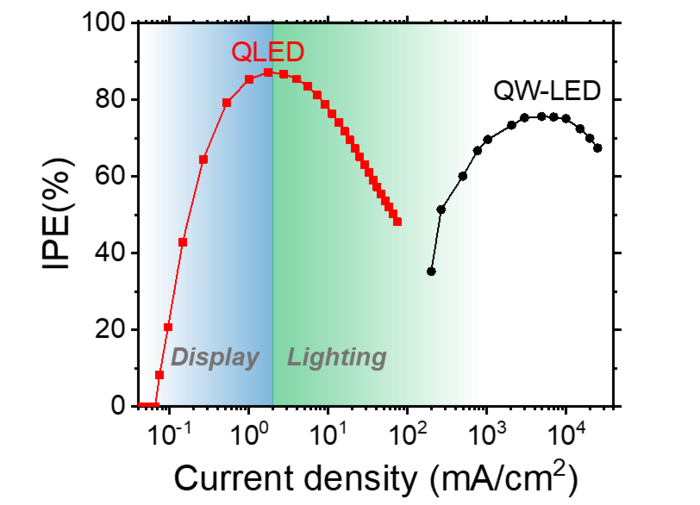Reviewed by Mila PereraSep 9 2022
LED lights, which stand for light-emitting diodes, have become widespread lighting options for homes and businesses, but standard LEDs have documented drawbacks when it comes to huge, high-resolution screens.
 This graph shows the improved conversion efficiency of QLEDs (IPE%) when compared to traditional LEDs (QW-LEDs). QLEDs can achieve a power conversion efficiency around 90%. Image Credit: Nano Research, Tsinghua University Press
This graph shows the improved conversion efficiency of QLEDs (IPE%) when compared to traditional LEDs (QW-LEDs). QLEDs can achieve a power conversion efficiency around 90%. Image Credit: Nano Research, Tsinghua University Press
LED displays use a high voltage and have a low internal power conversion efficiency, which means that the energy prices to operate the displays are expensive, the displays do not last as much, and they can get too hot.
Researchers detail how a technological advancement known as quantum dots could be the solution to some of these difficulties in a report published in Nano Research on August 26th, 2022. Quantum dots are artificial, microscopic crystals that function as semiconductors. They have unique features due to their size, making them valuable in display technology.
Traditional LEDs have been successful in fields like display, lighting, and optical communications. However, the technique used to acquire high-quality semiconductor material and devices is highly energy- and cost-consumptive.
Xing Lin, Assistant Professor, College of Information Science & Electronic Engineering, Zhejiang University
“Colloidal quantum dot provides a cost-effective way to construct high-performance LEDs using inexpensive solution processing techniques and chemical grade materials. Furthermore, as inorganic material, colloidal quantum dot surpasses emissive organic semiconductors in long-term operation stability,” Lin said.
LED displays are all made up of several layers. The emissive layer, where electric energy is converted into colorful light, is one of the most essential. The researcher utilized a single layer of quantum dots for the emissive layer.
Since the conductivity of colloidal quantum dot solid is low, the emissive layer usually causes voltage loss. Scientists claim that using mono-layer quantum dots as an emissive layer will decrease the voltage required to power these displays to the greatest extent possible.
One property of quantum dots that makes them excellent for LED usage is that they can be manufactured without efficiency, reducing imperfections. Quantum dots can be created without contaminants or surface flaws.
“Quantum dot LEDs (QLEDs) can achieve near unity internal power conversion efficiency at current densities suitable for display and lighting applications. Traditional LEDs, based on epitaxially grown semiconductors, exhibit serious efficiency roll-off in the same current density range. This difference originates from the defect-free nature of high-quality quantum dots,” said Lin.
Scientists claim that because of the inexpensive cost of creating emissive layers with quantum dots and the possibility to improve the light extraction efficiency of QLEDs using optical design techniques, QLEDs can be an effective upgrade over regular LEDs for lighting, displays, and beyond.
However, additional research is needed, and QLEDs, in their current form, have drawbacks that must be addressed before they can be extensively deployed.
Our work demonstrates that thermal energy can be extracted to boost the electrical-to-optical power conversion efficiency.
Xing Lin, Assistant Professor, College of Information Science & Electronic Engineering, Zhejiang University
“However, the device performance at the present stage is far from ideal in the sense of relatively high operating voltage and low current densities. These weaknesses can be overcome by seeking better charge transport material and engineering the interface between charge transport and quantum dot layers. The ultimate goal—achieving electroluminescence cooling devices—should be possible based on QLEDs,” said Lin.
Xingliang Dai, Zikang Ye, Yufei Shu, Zixuan Song, and Xiaogang Peng of Zhejiang University’s Departments of Chemistry, Material Science and Engineering, and Optical Science and Engineering also contributed.
The National Natural Science Foundation of China (62035013) and the Zhejiang Province Key Research and Development Program (2020C01001) funded this study.
Journal Reference:
Lin, X., et al. (2022) Highly-efficient thermoelectric-driven light-emitting diodes based on colloidal quantum dots. Nano Research. doi.org/10.1007/s12274-022-4942-x.